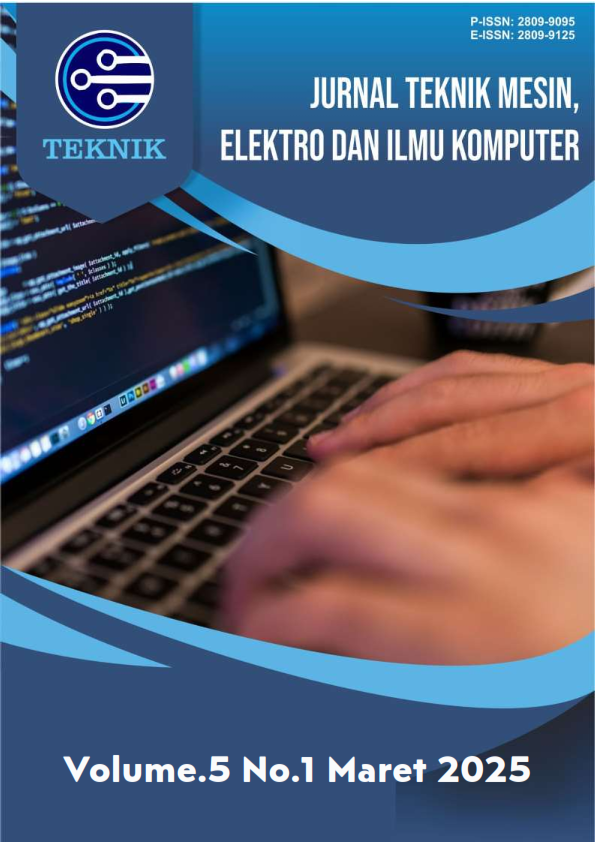Analisis Pengaruh Variasi Sudut Pengelasan terhadap Kualitas Las pada Material Baja High Strength Low Alloy dengan Meggunakan Metode Pengelasan Arc Welding
DOI:
https://doi.org/10.55606/teknik.v5i1.7053Keywords:
Welding angle, Welding quality, High Strength Low Alloy (HSLA) Steel, Arc Welding methodAbstract
In recent decades, research on welding has grown rapidly, especially in terms of finding more efficient welding techniques. The welding angle is very important because it can affect the quality of the weld. This welding angle has been studied by many researchers. One example is an experimental study that conducted welding of HSLA steel with various angles (30°, 45°, 60°, and 90°) using ARC welding at a speed of 150 A and 10 mm/s. This study found that a smaller welding angle can improve the tensile strength and toughness of low-alloy high-alloy steel materials. This study found that the choice of welding parameters significantly affects mechanical properties, including tensile strength and toughness, which are important for applications in industries such as automotive and construction.
References
[1] K. Lee, S. Yi, S. Hyun, and C. Kim, “Review on the Recent Welding Research with Application of CNN-Based Deep Learning Part II: Model Evaluation and Visualizations,” J. Weld. Join., vol. 39, no. 1, pp. 20–26, 2021, doi: 10.5781/jwj.2021.39.1.2.
[2] K. Schwarzkopf, R. Rothfelder, M. Rasch, and M. Schmidt, “Two-Color-Thermography for Temperature Determination in Laser Beam Welding of Low-Melting Materials,” Sensors, vol. 23, no. 10, 2023, doi: 10.3390/s23104908.
[3] M. Khedr, A. Hamada, A. Järvenpää, S. Elkatatny, and W. Abd-Elaziem, “Review on the Solid-State Welding of Steels: Diffusion Bonding and Friction Stir Welding Processes,” Metals (Basel)., vol. 13, no. 1, pp. 1–29, 2023, doi: 10.3390/met13010054.
[4] Y. Chen, X. Xu, Y. Liu, and H. Cui, “A Comparative Study on Microstructural Characterization of Thick High Strength Low Alloy Steel Weld by Arc Welding and Laser Welding,” Materials (Basel)., vol. 16, no. 6, 2023, doi: 10.3390/ma16062212.
[5] A. Sathish Kumar et al., “An intelligent fuzzy-particle swarm optimization supervisory-based control of robot manipulator for industrial welding applications,” Sci. Rep., vol. 13, no. 1, pp. 1–13, 2023, doi: 10.1038/s41598-023-35189-2.
[6] V. S. Chan, H. N. H. Haron, M. I. B. M. Isham, and F. Bin Mohamed, VR and AR virtual welding for psychomotor skills: a systematic review, vol. 81, no. 9. Multimedia Tools and Applications, 2022. Doi: 10.1007/s11042-022-12293-5.
[7] N. I. Fauziyah et al., “a Meta-Analysis of Risk Factors of Length of Exposure, Smoking Habits, Use of Personal Protection Equipment (Ppe), and Exposure To Welding Fumes in Welding Workers With Abnormal Pulmonary Function (a Perspective of Sustainable Public Health),” J. Kesehat. Lingkung., vol. 14, no. 1, pp. 1–10, 2022, doi: 10.20473/jkl.v14i1.2022.1-10.
[8] B. Zhou, T. Pychynski, M. Reischl, E. Kharlamov, and R. Mikut, “Machine learning with domain knowledge for predictive quality monitoring in resistance spot welding,” J. Intell. Manuf., vol. 33, no. 4, pp. 1139–1163, 2022, doi: 10.1007/s10845-021-01892-y.
[9] P. Rabe, U. Reisgen, and A. Schiebahn, “Non-destructive evaluation of the friction stir welding process, generalizing a deep neural defect detection network to identify internal weld defects across different aluminum alloys,” Weld. World, vol. 67, no. 3, pp. 549–560, 2023, doi: 10.1007/s40194-022-01441-y.
[10] U. Abdullahi, “Effect of Tempering Treatment on the Post-Weld Properties and Chemical Compositions of Arc-Welded Alloy Steels,” Int. J. Eng. Mater. Manuf., vol. 7, no. 4, pp. 89–94, 2022, doi: 10.26776/ijemm.07.04.2022.01.
[11] C. Gu, G. Feng, and G. Mi, “Advances in the Welding of Aluminum Matrix Composites: A New Open Special Issue in Materials,” Materials (Basel)., vol. 15, no. 15, p. 15155335, 2022, doi: 10.3390/ma15155335.
[12] C. González-González, J. Los Santos-Ortega, E. Fraile-García, and J. Ferreiro-Cabello, “Environmental and Economic Analyses of TIG, MIG, MAG and SMAW Welding Processes,” Metals (Basel)., vol. 13, no. 6, 2023, doi: 10.3390/met13061094.
[13] H. Jahns, J. Unglaub, J. Müller, J. Hensel, and K. Thiele, “Material Behavior of High-Strength Low-Alloy Steel (HSLA) WAAM Walls in Construction,” Metals (Basel)., vol. 13, no. 3, pp. 1–14, 2023, doi: 10.3390/met13030589.
[14] D. Fydrych, P. Raczko, A. Świerczyńska, M. Landowski, A. Wolski, and G. Rogalski, “Effect of Arc Strikes on High Strength Low Alloy Steels Welded by SMAW,” Adv. Sci. Technol. Res. J., vol. 17, no. 3, pp. 160–169, 2023, doi: 10.12913/22998624/166061.
[15] Y. Winardi, F. Fadelan, M. Munaji, and W. N. Krisdiantoro, “Pengaruh Elektroda Pengelasan Pada Baja AISI 1045 Dan SS 202 Terhadap Struktur Mikro Dan Kekuatan Tarik,” J. Pendidik. Tek. Mesin Undiksha, vol. 8, no. 2, p. 86, 2020, doi: 10.23887/jptm.v8i2.27772.
[16] E. D. A. N. Sipil, Z. H. Siregar, A. F. Nasution, M. Fazri, and R. Puspita, “THE EFFECT OF FUEL MIXTURE COMPOSITION ON GASOLINE,” vol. 05, no. 02, pp. 394–402, 2024, doi: 10.54123/vorteks.v5i2.389.
[17] S. Penttilä, H. Lund, and T. Skriko, “Possibilities of Artificial Intelligence-Enabled Feedback Control System in Robotized Gas Metal Arc Welding,” J. Manuf. Mater. Process., vol. 7, no. 3, 2023, doi: 10.3390/jmmp7030102.
[18] T. J. Saktisahdan, Z. H. Siregar, M. Mawardi, and A. Latif, “Effect of Physical and Mechanical Properties of Sa 333 Grade 9 Steel on Smaw Method Welding With E 7018 Electrodes,” Traksi, vol. 23, no. 1, pp. 138–151, 2023, [Online]. Available: https://jurnal.unimus.ac.id/index.php/jtm/article/view/10888
Downloads
Published
How to Cite
Issue
Section
License
Copyright (c) 2025 Jurnal Teknik Mesin, Elektro dan Ilmu Komputer

This work is licensed under a Creative Commons Attribution-ShareAlike 4.0 International License.








